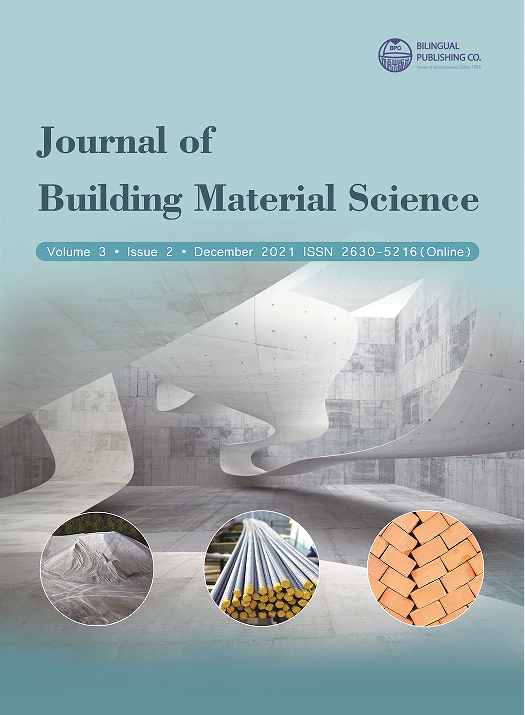
A Carbonation and Chloride Induced Corrosion Model for Hot-dip Galvanised Reinforcement Bar Material in Concrete
DOI:
https://doi.org/10.30564/jbms.v3i2.3150Abstract
This paper focuses on methodological issues relevant to corrosion risk prediction models. A model was developed for the prediction of corrosion rates associated with hot-dip galvanised reinforcement bar material in concrete exposed to carbonation and chlorides in outdoor environment. One-year follow-up experiments, over five years, were conducted at various carbonation depths and chloride contents. The observed dependence of corrosion rate on the depth of carbonation and chloride content is complex indicating that the interaction between the carbonation and chloride influencing the corrosion. A non-linear corrosion model was proposed with statistical analysis to model the relationship between the corrosion rate and the test parameters. The main methodological contributions are (i) the proposed modeling approach able to take into account the uncertain measurement errors including unobserved systematic and random heterogeneity over different measured specimens and correlation for the same specimen across different measuring times, which best suits the measurement data; (ii) the developed model in which an interaction parameter is introduced especially to account for the contribution and the degree of the unobserved carbonation-chloride interaction. The proposed model offers greater flexibility for the modelling of measurement data than traditional models.Keywords:
Concrete corrosion; Carbonation and chloride; Hot-dip galvanised concrete reinforcement; Crack; Corrosion modelReferences
[1] Tonini, DE., Gaidis, JM (1980) “Corrosion of reinforcing steel in concrete” A symposium, ASTM (Philadelphia), Conference Proceedings, 204p.
[2] Yeomans, SR (1994) Proceedings of International Conference held at the University of Shieffield. (Ed. R.N.Swamy), 24-28 July 1994, Sheffield Academic Press.
[3] Yeomans, SR (Ed.), Galvanized steel reinforcement in concrete, Elsevier (2004).
[4] Fratesi, G., Moriconi, IC. (1996) “The influence of steel galvanization on rebars behaviour in concrete”, Page, CL., Bamforth, PB., Figg JW (Eds.), Corrosion of Reinforcement in Concrete Construction, Royal Society of Chemistry (1996), pp. 630-641.
[5] Swamy, RN (1990) “Resistance to chlorides of galvanized rebars”, Page, CL., Treadaway, KWJ., Bamforth PB (Eds.), Corrosion of Reinforcement in Concrete, Elsevier Appl. Sci, London, New York, pp. 586-600.
[6] Sergi, G., Short, NR, Page, CL (1985) Corrosion, 41, Allen Press.
[7] Reale, T., O’Connor, A (2012) A review and comparative analysis of corrosion-induced time to first crack models, Construction and Building Materials, 36, 475-483.
[8] Otieno, M., Beushausen, H., Alexander, M (2012) Prediction of corrosion rate in reinforced concrete structures - a critical review and preliminary results, Mater. Corros., 63, 777-790.
[9] Ann, KY., Ahn, JH., Ryou. JS (2009) The importance of chloride content at the concrete surface in assessing the time to corrosion of steel in concrete structures, Construction and Building Materials, 23, 239-245.
[10] Otaduy, P., Karagiozis, A (2010) “Corrosion Prediction in Buildings Based on Simulation of Temporal Distribution of Humidity and Temperatures and the International Standard ISO-9223”, Proceedings of Thermal Performance of Exterior Envelopes of Whole Buildings XI, ASHRAE, 2010.
[11] Pular, P (1987) Corrosion Damaged Concrete, First Edition, Butterworths, p99, London, UK.
[12] Sistonen, E., Puttonen, J (2010) “Durability study of hot-dip galvanized reinforcement bars in carbonated and chloride-contaminated concrete”. 3rd fib International Congress, May 29 - June 3, Washington D.C., USA.
[13] Akaike, H (1974) A new look at the statistical model identification”. IEEE Transactions on Automatic Control, 1974, 19 (6), 716-723.
[14] Ross, SM (2014) Introduction to probability and statistics for engineers and scientists, Academic Press.
[15] Lacasse, MA., Vanier, DJ (1999) “Durability of Building Materials and Components 8: Durability of building assemblies and methods of service life prediction”, NRC Research Press National Research Council of Canada, 1999.
[16] Costa, A., J. Appleton, J (2001) Concrete carbonation and chloride penetration in a marine environment, Concrete Science and Engineering, 3, 242-249.
[17] Boulfiza, M., Sakai, K., Banthia, N., Yoshida, H (2003) Prediction of Chloride Ions Ingress in Uncracked and Cracked Concrete. ACI Materials Journal. 100, 38-48.







 xiaoshu Lü
xiaoshu Lü





